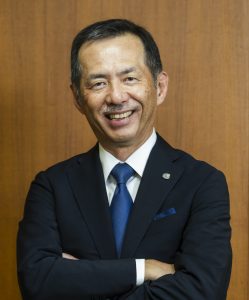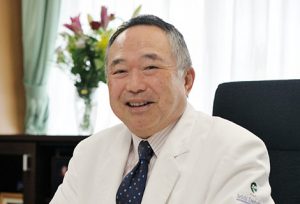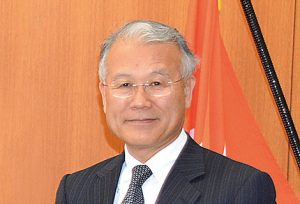; ?>/img/message/thm01.jpg)

President, Nagasaki University
For the development of global specialists in the field of radiation medical sciences
Originally, Nagasaki’s hope was that we would be the last Hibakusha, and so our aspiration was to conclude the medical care of Hibakusha in Hiroshima and Nagasaki. But the knowledge that we have collected in Nagasaki has come to play an important role in addressing radiation disasters that should never have come about. These include the accidents at Chernobyl Nuclear Power Plant in 1986 and the TEPCO Fukushima Daiichi Nuclear Power Station, which followed the Great East Japan Earthquake on March 11, 2011. In the 12 years since the accident in Fukushima, Nagasaki University has, while helping to support the medical system in the Fukushima prefecture, formed a close partnership with Fukushima Medical University, including the establishment of radiation emergency medicine and the launch of the Fukushima Health Management Survey.
Division of Disaster and Radiation Medical Sciences was established by Nagasaki University and Fukushima Medical University in 2016 as a joint master course program. It is the realization of the combined efforts of the two universities, and was launched with the goal of developing specialists in disaster and radiation medical sciences, a shortage that was laid bare by the accident.
Essentially, however, the radiation medical sciences should be prepared in tandem with the development and promotion of nuclear power and other uses of radiation. In that sense, experiences of Nagasaki and Fukushima should be shared with others in the world. To develop worldwide specialists in this field, all lectures and training are conducted in English for foreign students. Dr Jacques Lochard, Former Vice Chairman of the International Commission on Radiological Protection (ICRP) and a worldwide authority in the field of radiation protection, has been appointed the professor for this course. In addition to undertaking the training and education of students, the program has assembled a teaching staff with a wealth of experience in international institutions to provide education at the global level.
Modern society is facing a variety of risks, in addition to radiation exposure. In this course, under the close partnership of the two universities, we will produce a new generation of radiation health risk specialists who will be active in the field. I strongly believe that, having experienced an atomic bombing and nuclear disaster, respectively, this work will prove to be the historic legacy of Nagasaki and Fukushima.
; ?>/img/message/thm02.jpg)

President, Fukushima Medical University
Fostering and development of professionals who fulfill the role of “The Specialist” in times of adversity including natural, nuclear or other complex disasters.
Since the Great East Japan Earthquake, Fukushima Medical University has made every effort to provide support for the revitalization of Fukushima from a health and medical perspective.
In the chaotic aftermath of the disaster, there was a shortage of medical professionals capable of fulfilling the demand of the community due to the lack of knowledge in the field of radiation disaster medicine and the complexity of the disaster itself.
During the transition from the acute to chronic stage of the disaster, the lack of leadership and proactivity can result in insufficient support for the evacuated residents and their well-being, as well as delays in the establishment of effective relationships between the municipalities and professionals.
Our mission has since been to fully commit to the revitalization of Fukushima through fostering and training medical professionals to improve the workforce dealing with such complex disasters.
To achieve the mission, in corporation with Nagasaki University, we have established a postgraduate program (Masters) for ‘Disaster and Radiation Medical Sciences’, which began in April 2016. The curriculum includes courses on Radiation Exposure Medicine provided by Nagasaki University and Disaster Medicine by Fukushima Medical School.
This joint university program has students with diverse academic and occupational backgrounds, such as nurses, public health nurses, as well as fire fighters. We believe that the participants will be able to add to their expertise through further education and better understanding of Disaster and Radiation Medical Sciences. The enhanced knowledge in the subject will enable these professionals to make a significant contribution in disaster response.
Regardless of the circumstances, Human Resources is the single most important factor for revitalization following disaster. We seek motivated and ambitious professionals of all related backgrounds aiming at contributing to all stages of revitalization.
; ?>/img/message/thm03.jpg)

Nagasaki University Executive/Vice President
Fukushima Medical University Vice President
We provide specialized learning experiences to prepare for emergencies and complex disasters.
In modern society, where we are supported by technological development, we are always operating alongside unknown risks. Since the Fukushima Daiichi nuclear power plant accident in 2011, Nagasaki University and Fukushima Medical University have cooperated toward the reconstruction of Fukushima. In April 2016, Nagasaki University and Fukushima Medical University will found a joint graduate school (Master’s degree level) specializing in medical science and health nursing science. In the future, preparation and provision against nuclear disasters and radiation accidents will be urgent issues, not only in Japan, but also in foreign countries including other Asian nations. In our courses, the two universities demonstrate their experience and the strengths of their distinctive scholastic environments and guidance systems, in which all students will learn the risks of regulatory science based on natural science and social science, in order to prepare for emergencies and complex disasters. We will produce the human resources essential for the field of disaster and radiation exposure medical science, people who can lead the way in the reconstruction and recovery from such disasters.